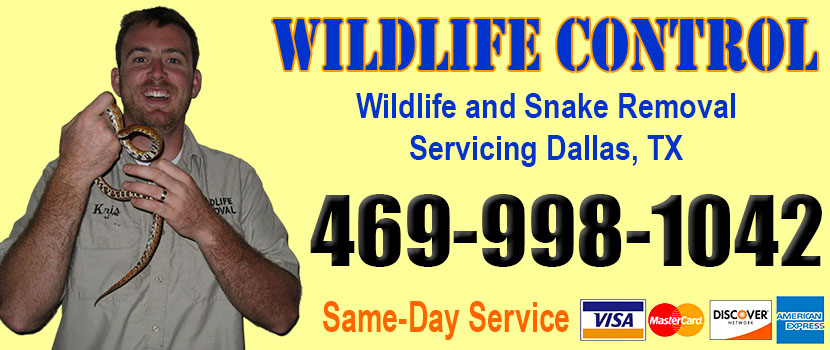
Welcome to dallassnakes.com! I am David, a snake enthusiast living in Dallas, TX. Many people don't know that Dallas is in fact full of snakes! You just need to know where to find them - they can often be shy and elusive. Some Texas snake species are more common outside of the city limits, in different parts of Dallas County TX, but many types of snakes are indeed common in the more urban parts of Dallas. This guide is meant to help educate you about the beautiful snakes of Dallas, and to help you identify the most common snakes of Dallas, as well as the venomous snakes of Dallas that you should learn to recognize and avoid. If you want more detail, click here for my complete list of ALL snake species in Dallas. Remember the following:
- Most snakes of Dallas are harmless and don't want to encounter you
- Venomous snakes exist but are uncommon in Dallas, Texas
- Snakes eat rats and mice and are a valuable part of the Texas ecosystem
- Never kill a snake - if you leave a snake alone, it will leave you alone.
Common Snake Species in Dallas
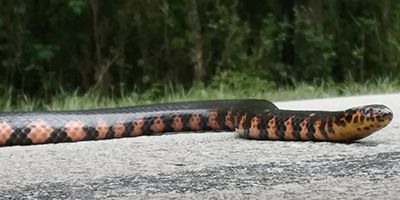 Mud Snake:
Mud snakes (Farancia abacura) are a nonvenomous species of snake, which, as their name suggests, commonly resides in the mud. Such semi-aquatic environments include lakes, rivers, wetlands, and the intertidal zone. They are commonly found in the Dallas-Fort Worth area. However, they will rarely leave the water and are primarily active at night.
Growing to around 40 to 54 inches in length, mud snakes have a glossy black back and a bright red underbelly. They are carnivorous, preying upon giant aquatic salamanders and other amphibians.
Mud Snake:
Mud snakes (Farancia abacura) are a nonvenomous species of snake, which, as their name suggests, commonly resides in the mud. Such semi-aquatic environments include lakes, rivers, wetlands, and the intertidal zone. They are commonly found in the Dallas-Fort Worth area. However, they will rarely leave the water and are primarily active at night.
Growing to around 40 to 54 inches in length, mud snakes have a glossy black back and a bright red underbelly. They are carnivorous, preying upon giant aquatic salamanders and other amphibians.
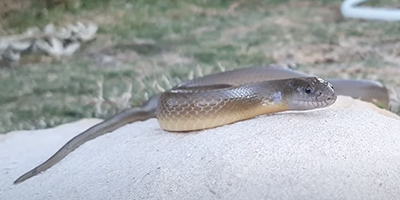 Common Ground Snake:
The western or common ground snake (Sonora semiannulata) is a small and non-venomous snake that prefers dry and rocky landscapes. It is nocturnal and secretive, but can often be spotted by roadsides. It has an easily recognizable look, being bright orange with black or brown banding.
However, the patterning and coloration can be very dependent on the specific geographic region. Therefore, identifying ground snakes is a tricky business. Individuals rarely grow larger than 19 inches. As such, common ground snakes primarily hunt invertebrates such as spiders, scorpions, crickets, centipedes, and insect larvae.
Common Ground Snake:
The western or common ground snake (Sonora semiannulata) is a small and non-venomous snake that prefers dry and rocky landscapes. It is nocturnal and secretive, but can often be spotted by roadsides. It has an easily recognizable look, being bright orange with black or brown banding.
However, the patterning and coloration can be very dependent on the specific geographic region. Therefore, identifying ground snakes is a tricky business. Individuals rarely grow larger than 19 inches. As such, common ground snakes primarily hunt invertebrates such as spiders, scorpions, crickets, centipedes, and insect larvae.
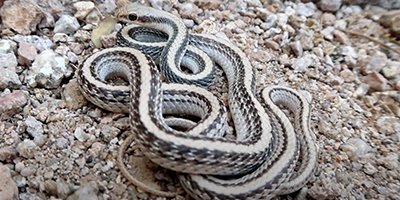 Long-nosed Snake:
The long-nosed snake (Rhinocheilus lecontei) is a colorful serpent found throughout Texas. Characteristically, it has a long, upturned nose – hence the name. Its body has three colorings: black, red, and an underlying yellow or white. On average, these snakes rarely reach over 30 inches long.
Spending most of their time buried underground, it hunts at night. Common prey includes lizards, amphibians, and other smaller snakes. As it is not venomous, it is unlikely to bite. However, long-nosed snakes are known to release a foul-smelling musk as a defense mechanism.
Being somewhat tolerant of human disturbance, it will be seen in agricultural lands and occasionally gardens. It is entirely harmless and poses no threat to humans.
Long-nosed Snake:
The long-nosed snake (Rhinocheilus lecontei) is a colorful serpent found throughout Texas. Characteristically, it has a long, upturned nose – hence the name. Its body has three colorings: black, red, and an underlying yellow or white. On average, these snakes rarely reach over 30 inches long.
Spending most of their time buried underground, it hunts at night. Common prey includes lizards, amphibians, and other smaller snakes. As it is not venomous, it is unlikely to bite. However, long-nosed snakes are known to release a foul-smelling musk as a defense mechanism.
Being somewhat tolerant of human disturbance, it will be seen in agricultural lands and occasionally gardens. It is entirely harmless and poses no threat to humans.
Venomous Snake Species in Dallas
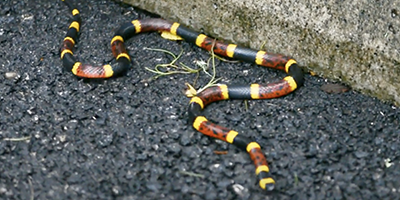 Texas Coral Snake:
The Texas coral snake (Micrurus tener) is found throughout the southern United States and northern Mexico. It has typical coral snake coloring, with rings of black, yellow, and red. At most, it grows to 48 inches, though most are much smaller than this. It has a slender body and a rounded head.
Despite being shy creatures, they contain a potent neurotoxin which leads to neuromuscular dysfunction. This venom is potentially deadly, although deaths are rare. However, they will rarely bite; instead preferring to hunt earth snakes.
Texas Coral Snake:
The Texas coral snake (Micrurus tener) is found throughout the southern United States and northern Mexico. It has typical coral snake coloring, with rings of black, yellow, and red. At most, it grows to 48 inches, though most are much smaller than this. It has a slender body and a rounded head.
Despite being shy creatures, they contain a potent neurotoxin which leads to neuromuscular dysfunction. This venom is potentially deadly, although deaths are rare. However, they will rarely bite; instead preferring to hunt earth snakes.
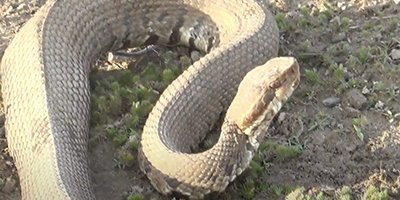 Cottonmouth:
Found throughout the south, cottonmouths (Agkistrodon piscivorus) – also known as the water moccasin – is an aquatic snake. The subspecies common to northern Texas is A. p. leucostoma, the smallest type. As strong swimmers, they are found near creeks, streams, marshes, ponds, and lakes.
These snakes are venomous and are likely to show a defensive display. However, they will only bite if picked up. Deaths from venom are rare, but a bite can lead to amputation.
Look for a dark olive or brown colored snake, with subtle banding. They are heavy-bodied and measure around 26 to 35 inches in length.
Cottonmouth:
Found throughout the south, cottonmouths (Agkistrodon piscivorus) – also known as the water moccasin – is an aquatic snake. The subspecies common to northern Texas is A. p. leucostoma, the smallest type. As strong swimmers, they are found near creeks, streams, marshes, ponds, and lakes.
These snakes are venomous and are likely to show a defensive display. However, they will only bite if picked up. Deaths from venom are rare, but a bite can lead to amputation.
Look for a dark olive or brown colored snake, with subtle banding. They are heavy-bodied and measure around 26 to 35 inches in length.
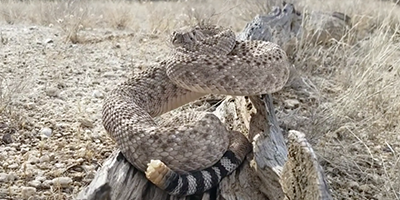 Western Diamondback Rattlesnake:
This venomous pit viper contains a powerful venom that acts by breaking down the proteins in our tissues. The western diamondback rattlesnake or the Texas diamondback (Crotalus atrox) is responsible for the greatest number of snakebites in the US. If bitten, seek immediate help. However, their venom is less toxic than many other rattlesnakes.
Adults grow to 4 ft. in length and have a recognizable triangular head. As their name suggests, their backs are patterned with dark brown diamond shapes, from head until the rattle of their tail. They mostly hunt for small mammals such as prairie dogs, voles, rabbits, and ground squirrels.
Western Diamondback Rattlesnake:
This venomous pit viper contains a powerful venom that acts by breaking down the proteins in our tissues. The western diamondback rattlesnake or the Texas diamondback (Crotalus atrox) is responsible for the greatest number of snakebites in the US. If bitten, seek immediate help. However, their venom is less toxic than many other rattlesnakes.
Adults grow to 4 ft. in length and have a recognizable triangular head. As their name suggests, their backs are patterned with dark brown diamond shapes, from head until the rattle of their tail. They mostly hunt for small mammals such as prairie dogs, voles, rabbits, and ground squirrels.
If you're unsure, you can email me a photo of the snake at info@dallassnakes.com and I will email you back with the snake's species. If you found a snake skin, read my Found a Skin? page, and you can email me a photo of the skin, and I'll identify the snake for you. If you need professional Dallas snake removal help, click my Get Help page, or see the below website sponsor I found, who provides that service.
What is snake venom and how does it work?
All About Snake Venom
Certain types of snakes have venom. At some point, you have likely heard of venom and have a good idea of what it is. Venom can paralyze and kill, and is dangerous to most. To humans, certainly, it poses significant threats. Snake venom can do anything from cause tissue damage to causing death. It is not something to take light whatsoever. You may know this, on a basic level, but there is more to venom than what it does. There is how it does this, how it helps the snake, and what types of snakes carry the venom. There is a lot more to know about venom than the basics.
What is Venom?
Composed of proteins and enzymes, snake venom is a natural part of snakes. The fluid drips from their mouth, usually when biting a prey, and can cause tissue and nerve damage – potentially even death. When the snake bites down on its prey, it will inject it with the venom. The venom will begin to break down the prey, causing paralysis, tissue death, and death. Venom is a powerful tool for snakes that have it. It allows the snake to kill its prey for an easier meal and it gives the snake an extra layer of protection if something threatens it. For food, the venom does not harm the snake when consumed. Snakes can consume the venom perfectly fine without any negative health risks.
Snakes and Venom
Not all snakes are venomous, and not all venom is the same. Some snakes have no venom at all, whereas others are deadly. Before you go near or handle any snakes, consider whether it is venomous. You should not go near wild snakes in general, but this is important information if the situation ever arises. Look at snakes in your area and learn about which ones are venomous, as well as how you can spot a venomous snake.
Uses of Venom
Venom, when injected via a snake bite, is deadly. Venom, when used in medicine or ingested, is not. Some of the effects of venom, when used in medicine, can assist in health issues, like high blood pressure. Medical professionals have found that venom is powerful in keeping certain situations. Snake venom plays a vital role for snakes and humans alike. Snakes use it for their own survival, and humans do the same, to an extent. It is powerful in how many uses it has.
Remember, the term is not poisonous snakes of Dallas, it's venomous snakes of Dallas. Poison is generally something you eat, and venom is injected into you. That said, dangerous snakes are very rare in Dallas. The few venomous snakes of Dallas County are rarely seen. But they are commonly misidentified, so learn about all the snake species of Dallas in order to correctly identify them. These snakes are usually also found in the surrounding towns of Irving, Garland, Highland Park, Addison, DeSoto , University Park, Farmers Branch, Duncanville, Lancaster, Balch Springs, Sunnyvale, Hutchins, Cockrell Hill, Wilmer, and the surrounding areas.
Read our article about:
Where Can I Take A Trapped Snake?
dallassnakes.com domain and hosting costs made possible by the generous support of this sponsor:
